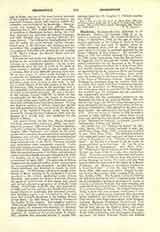

Charlevoix, FRANCOIS-XAVIER, historian, b. at St-Quentin, France, October 24, 1682, d. at La Fleche, February 1, 1761. He entered the Society of Jesus, September 15, 1698, at the age of sixteen, studied philosophy at the College de Louis le Grand (1700-1704), and then went to Quebec, where he taught grammar from 1705 to 1709. During the years spent in Canada, he gathered material for his future “History of New France“. He returned to Paris in 1709 and studied theology for four years. In 1720, under instructions from the French Court, he began his travels through the French colonies to gather information for the discovery of the Western sea. He embarked, at La Rochelle in July of that year, and reached Quebec towards the end of September. He proceeded up the St. Lawrence River and through the Great Lakes to Michillimackinac, from which place he journeyed to the lower end of the territory of the Puans or Winnebago Indians. Entering Lake Michigan he continued along the eastern shore and at length after much endeavor reached the Illinois, whence he descended the Mississippi to its mouth. The vessel upon which he embarked for San Domingo was wrecked near the Bahamas and the expedition was temporarily abandoned.
Charlevoix and his companions returned to the Mississippi by way of the coast of Florida. His second attempt to gain the Island of San Domingo proved more successful, and he reached this colony at the beginning of September, 1722, and left at the end of the same month. He embarked for Havre December 24, 1722. After his return to France, in 1723, he made a journey to Italy, fulfilling the various duties of his order and working for twenty-two years as an editor of the “Memoires de Trevoux”, a monthly journal of bibliography, history, and science. His works are: (I) “Histoire du Japon” (3 vols., 12mo, Rouen, 1715); entirely rewritten (2 vols., 4to, and 9 vols., 12mo, Paris, 1736); revised and reedited (6 vols., 12mo, Paris, 1754). The history is enriched with maps and plates, and embraces all that is interesting in Kampfer’s work, “History of Japan and Siam”. At the end is a resume of all the works on Japan published up to that time. (2) “La Vie de la Mere Marie de I’Incarnation” (8vo, Paris, 1724). (3) “Histoire de l’Isle Espagnole ou de S. Domingue” (2 vols., 4to, Paris, 1730-31; 2 vols., 8vo, Amsterdam, 1733). This work was compiled from data and manuscripts furnished him by Pere Le Pers, who had lived in San Domingo for twenty-five years, and also from reports which are preserved in the Depot de la Marine of France. (4) “Histoire et description generale de la Nouvelle-France” (3 vols. 4to, and 6 vols. 12mo, Paris, 1744), with maps and plates; English translation (2 vols., 8vo, London, 1761; London, 1763; 2 vols., 8vo, Dublin, 1766). The English version of 1763 has the following descriptive title: “Letters to the Duchess of Lesdiguieres; giving an Account of a voyage to Canada, and travels through that vast Country, and Louisiana to the Gulf of Mexico. Undertaken By Order of the present King of France. By Father Charlevoix. Being a more full and accurate description of Canada, and the neighboring Countries than has been before published; the character of every Nation or Tribe in that vast Tract being given: their Religion, Customs, Manners, Traditions, Government, Languages, and Towns; the Trade carried on with them, and at what places; the Posts or Forts, and settlements, established by the French; the Great Lakes, Water Falls and Rivers, with the manner of navigating them; the Mines, Fisheries, Plantil, and Animals of these Countries. With reflections on the Mistakes the French have committed in carrying on their Trade and Settlements; and the most proper method of proceeding pointed out. Including also an account of the Author’s Shipwreck in the Channel of the Bahamas, and return in a boat to the Mississippi, along the Coast of the Gulf of Mexico, with his voyage from thence to St. Domingo and back to France.” John Gilmary Shea issued a translation in six volumes (New York, 1866-72). The edition, limited to 25 copies in quarto and 250 in octavo, contains several portraits engraved on copper (cf. J. R. G. Hassard, in Catholic World, September, 1873). (5) “Histoire du Paraguay” (3 vols., 4to, Paris, 1756; 6 vols., 12mo, Paris, 1757; tr., 2 vols., 8vo, London 1769). (6) “Eulogy on Cardinal de Polignac”, published in the “Memoires de Trevoux”, 1742, pp. 1053-1091. (7) “Suggestions for a History of the New World”, founded upon the chronological records of America, also in the “Memoires de Trevoux”, 1735, pp. 161-172, and inserted in the “History of New France“.
What the critics thought of his works may be found in his own preface to “L’Histoire de la Nouvelle-France“. One censor found the whole first volume useless, another complained that he was too concise. He is accused of depreciating Kampfer’s work in the “Histoire du Japon” and of having given too much space to religious matters. Rochemonteix, though regarding him as a “historien de valeur”, finds fault with him for occasional carelessness and for differing somewhat in his history from the accounts of the missionaries. With regard to his “Histoire de la Nouvelle-France“, John Gilmary Shea says that “it is too well known and too highly esteemed both for style and matter to need any explanation of its scope or object. The praise of Gibbon will alone assure the reader that as an historical work it is of no inconsiderable merit”.
E. P. SPILLANE

